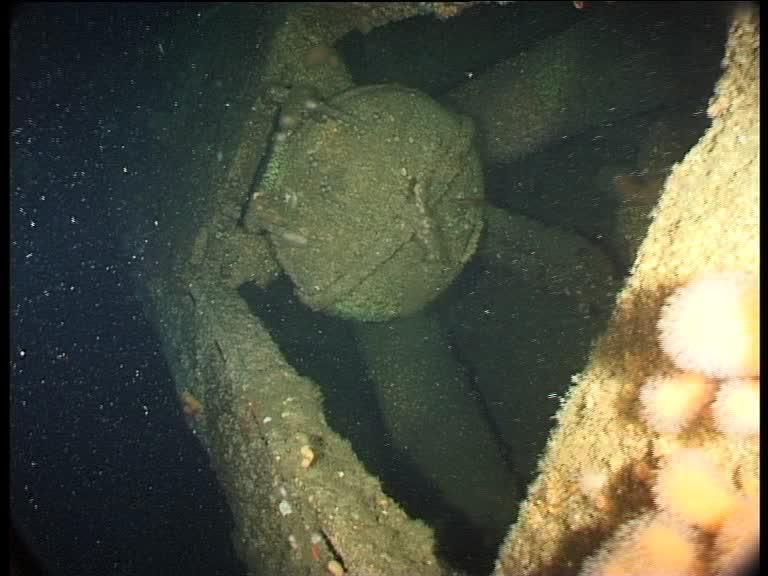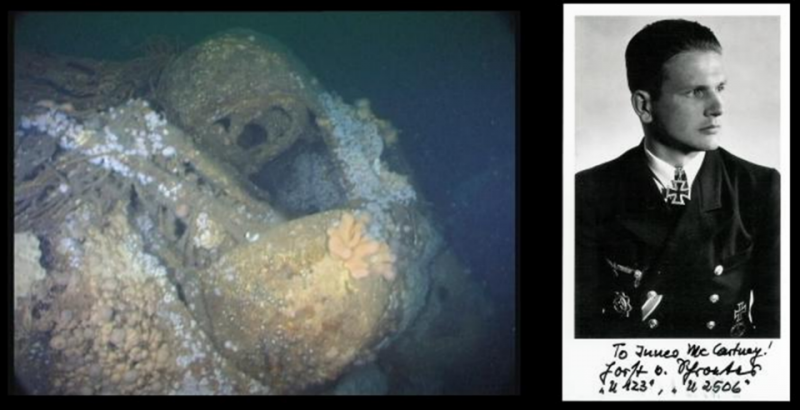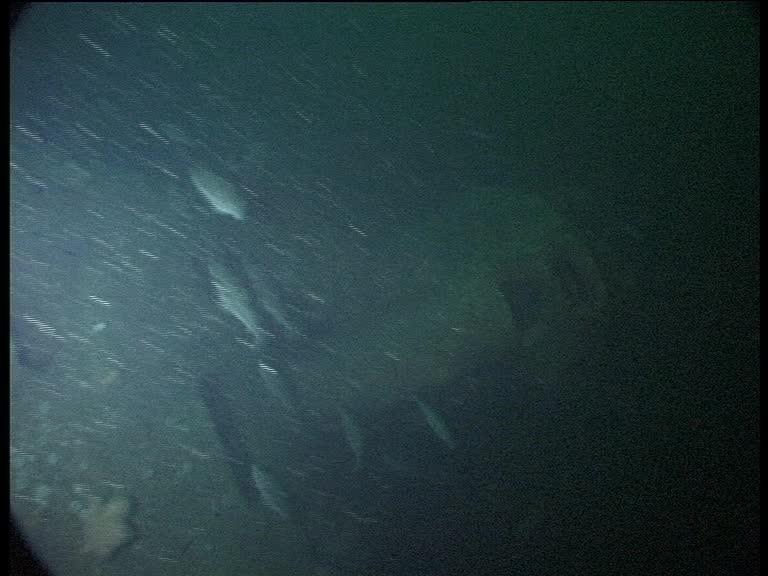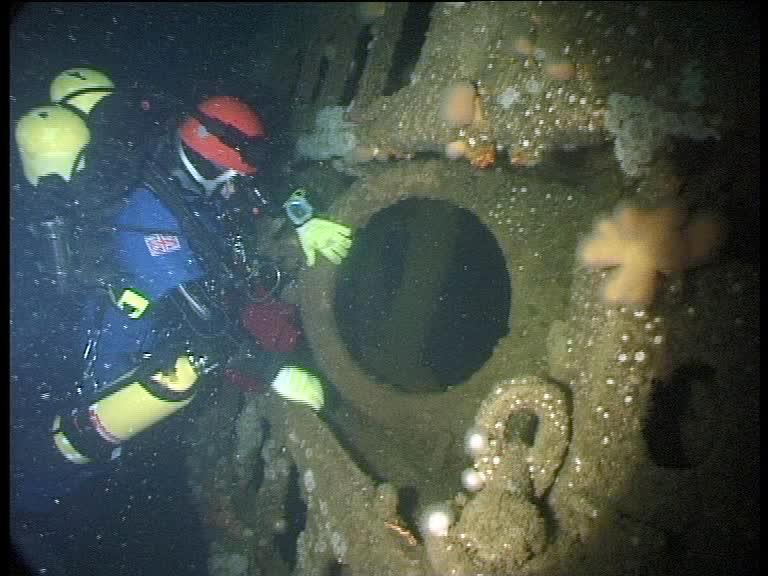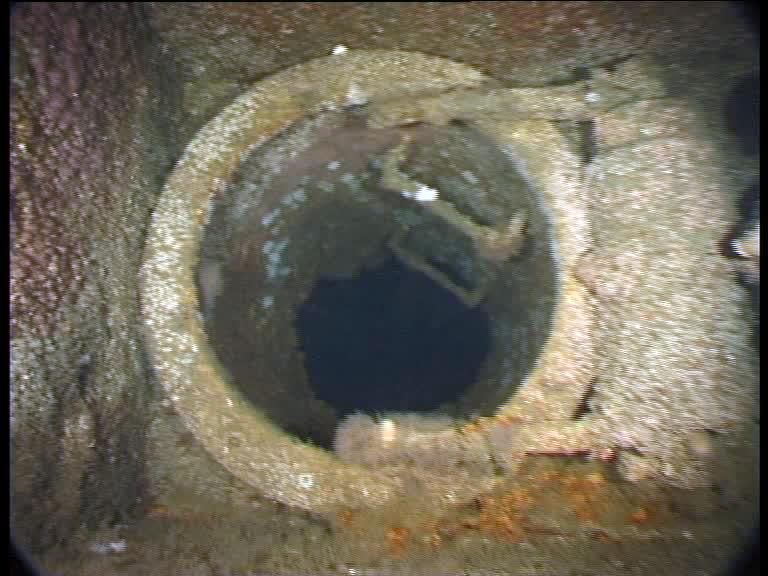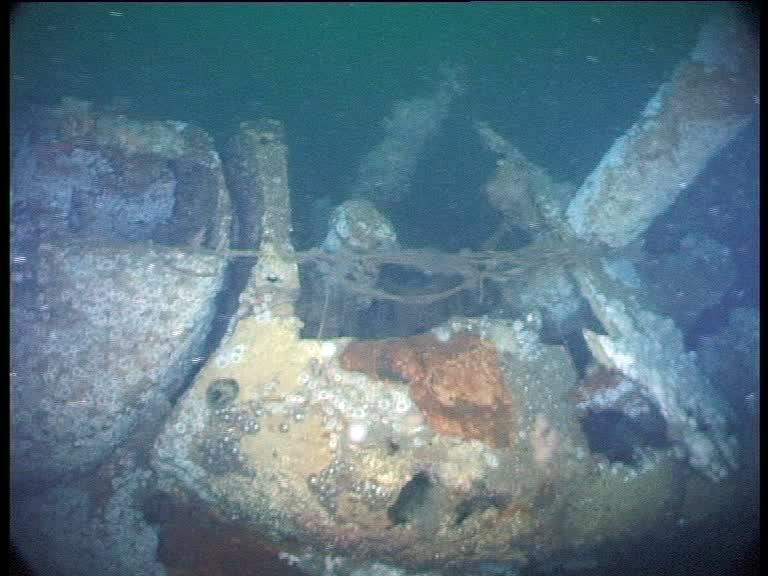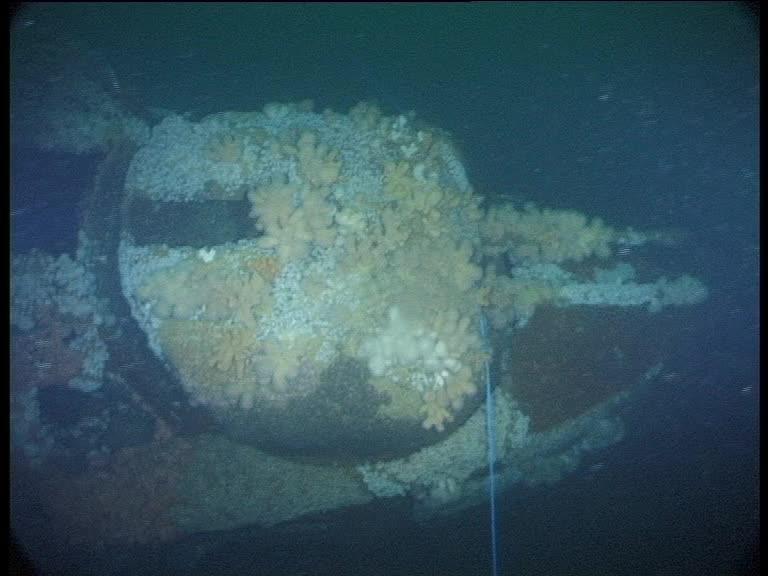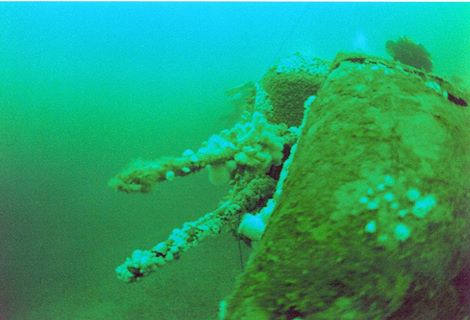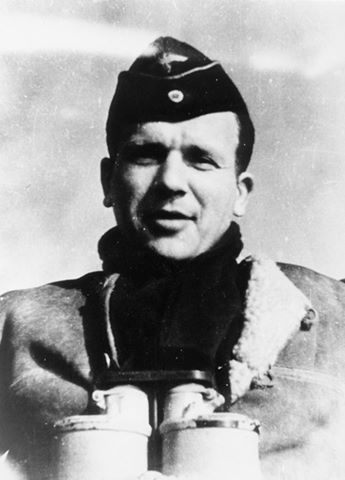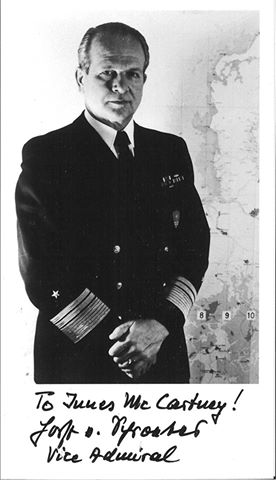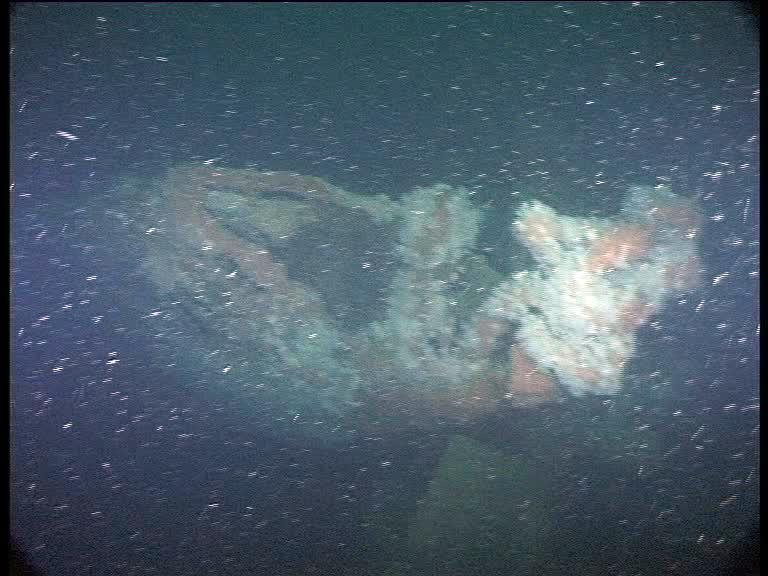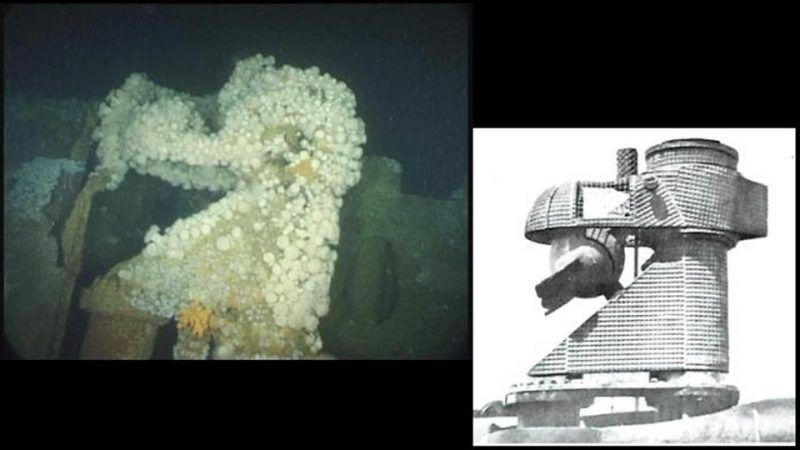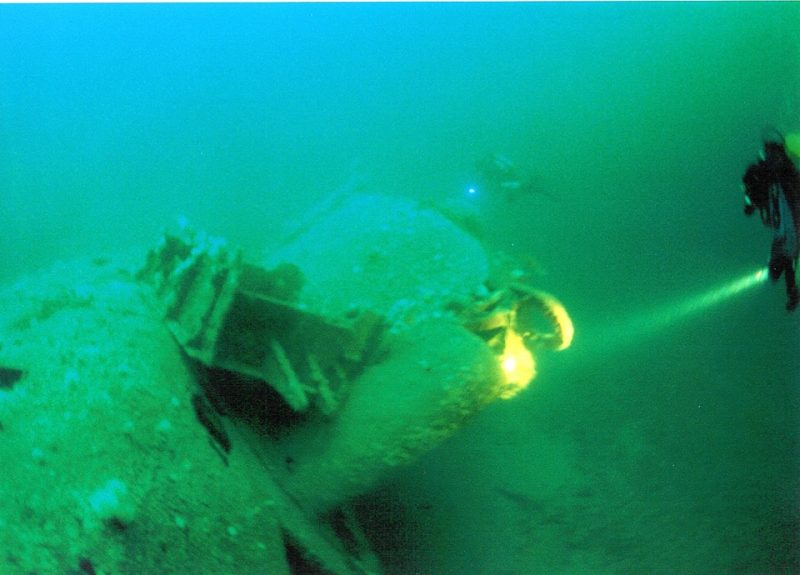
By Dr Innes McCartney
During the Operation Deadlight Expeditions, we aimed to find, record and identify some of the 116 U-boats that were dumped at sea after WW2 off Northern Ireland. While many of them were standard types, there were among the Deadlight fleet a few of the more ‘exotic’ designs; none more so, than the two Type XXI U-boats we dived. While one had already been found, the other had not. It was one of the key expedition targets. It took over a month of diving over a two-year period to finally locate her. The discovery of U2506 and what happened subsequently has been a very memorable chapter in my career as an archaeologist and diver.
Operation Deadlight Background
When WW2 ended, the Allies kept a few U-boats for technical evaluation. However, the rump of the U-boat fleet was to be put out of reach of all the winning powers by disposing of them at sea. This task was handed to the Royal Navy and the U-boats allocated for disposal were gathered together at Loch Ryan and Lisahally.
Skeleton teams made up of the original German crews were keeping the submarines in running order. Once the allies rooted out the Nazi party members from the rest, the U-boat men, not only became an integral part of the disposal operation, but many lifelong friendships were formed, with several German sailors later living in Scotland and Northern Ireland.
The unenviable task of disposing of the U-boats at sea, “in over 100 metres” had to be completed by February 1946. With the stroke of a pen, the Admiralty had been tasked with towing the submarines into the teeth of the North Atlantic in winter. It isn’t particularly surprising therefore, that “Operation Deadlight”, was to prove to be difficult to carry out.
Experience had already told the Royal Navy that submarines on tow tended to over-strain tow cables, or simply founder. Explosive charges set inside each U-boat were wired to a buoy that was trailed behind them. It was also decided to give submarine and air crew the opportunity to sink some of the U-boats too. But things didn’t go entirely to plan. U-boats foundered on tow, the tow cables broke, demolition charges failed, towing ships ran aground. Bad weather hampered everything. It also put pay to several air and torpedo exercises. In all, only 58 (exactly half) of the U-boats reached the disposal area. The rest lie scattered in a line across the north coast of Donegal and range in depth from 46 metres to 130 metres.
This historic wreck was once commanded by Horst von Schroeter, the famous U-boat commander and NATO Admiral. I wrote to him after the dives and we occasionally corresponded until he passed away. The tape of this dive was shown at the last U2506/U123 crew reunion and was a popular feature, he told me (Innes McCartney). — at Malin Head.
The table I put together below compares how the “Operation” was planned and executed. The results are surprising, clearly showing that things did not run smoothly.
Planned Actual
Demolition 69 2
Air Attack 29 13
Submarine 13 8
Gunfire 5 73
Foundered nil 20
I have recently made contact with the captain of one of the towing ships at Deadlight. In the light of the experiences he has shared with me I have formed the view that under the circumstances the Royal Navy made the best of a bad job. While some historians have labelled Deadlight a farce, I prefer to see it as difficult undertaking executed in the best possible way that the limited timeframe allowed. At least the deadline of February 1946 was met.
In the darkness the ghostly shape of the conning tower appears (Innes McCartney)
The Type XXI U-boat – Wonder weapon of the Kriegsmarine
As with the Tiger tank and the Messerschmitt 262, the German’s turn to technology to make up for quantitive deficiencies at the front also manifested itself in naval construction. By 1943 it had become obvious that existing classes of U-boat dangerously obsolete. Perhaps the most remarkable aspect of the Type XXI U-boat was its inception to construction timetable, which lasted 18 months from initial design proposal to the first one being launched in May 1944. Not surprisingly however, such a rushed program of development left many problems that had to be resolved during later construction and commissioning. These, coupled with the attention of allied bombers, much delayed the deployment of the Type XXI to the front.
The Type XXI U-boat represents one of the greatest and most revolutionary submarine designs ever. The quantum leap in technology that these submarines represented came too late to save Germany. However there is no doubt that had the Type XXI become operational at the end of the war, it would have been a menace to the allies.
The Type XXI was essentially the world’s first true submarine, designed to operate entirely underwater. It could do this because it was fitted with an extremely large array of batteries. In fact the pressure hull had to be configured in a figure-eight profile, (with the lower portion being devoted to batteries) in order to accommodate them. At five knots the batteries allowed for a run of 340 miles submerged. More alarmingly for the allies was the capability for the Type XXI to run at 15 knots submerged for 30 miles or more. – a speed which would allow it to outrun many of its foes.
U2506 was lost on tow. The tug which lost it only gave a vague position for the loss, so it took a few dives to find it. ON this dive, as soon as Greg and me arrived we knew we were looking at the unmistakeable wreck of a Type XXI U-boat. This is the torpedo loading hatch (Innes McCartney).
While the schnorchel had been retrofitted to the existing German submarine designs by the end of the war, the Type XXI was the first submarine to have one fitted into it as original equipment. Besides being able to allow the submarine to run at 6 knots submerged on diesel power, the schnorchel allowed for battery re-charging and air replenishment without the need to surface. Since airborne radar had become the U-boats most dangerous enemy, the ability to remain constantly submerged was a major asset to the Germans.
The Type XXI design also incorporated the latest torpedo technology. The T5 (2) torpedo was acoustic homing; essentially a fire and forget weapon. Coupled with the revolutionary sonar array developed for the Type XXI, it meant that the submarine could fire its torpedoes from a depth of 50 metres, on sonar bearing alone, without the use of the periscope. Moreover the Type XXI was fitted with hydraulic torpedo loading. This meant that it could fire no less than 18 torpedoes in less than 30 minutes without the need to disengage from action. One can only imagine the chaos, which one Type XXI could have wrought upon an allied convoy.
To escape after attack, the Type XXI was fitted with silent motors too. At six knots it was undetectable by hydrophone. Other technical firsts for German submarines also appeared in the Type XXI, including hydrostatic depth keeping equipment, increased crew comfort, deep freezers for fresh food and armoured anti-aircraft turrets.
The aft deck hatch is open, but unlike U2511, there is no way to enter the submarine (Innes McCartney).
The bombing carried out all over Germany to disrupt its construction is evidence of the seriousness with which the allies treated the potential threat posed by the Type XXI. Albert Speer, Minister for Armaments had developed a production system for the Type XXI which utilised 32 different factories miles inland to build modular hull sections, which were then barged to 11 different shipwards to be assembled and fitted out. It is remarkable that so late in the war 94 of these submarines were working-up in Norway and Germany and were weeks away from being unleashed on the allies.
However, very few Type XXIs survive anywhere in the world today. While U2540 exists as a museum piece at Bremerhaven, its use as a post-war test bed so altered it that it is a wartime Type XXI in spirit only. The three Type XXIs found in a bunker in Hamburg in 1985 have been buried under tons of gravel.
Most of the others were broken up after the war. So Type XXI wrecks are rare, but at Operation Deadlight we now have two, and potentially more. As previously reported, we dived U2511 in 2001 and found her to be in fairly good condition. But the one we found and were the first ever to dive on, in 2002 is completely intact! – She is U2506 and what a merry chase she led us!
The bridge – so much more intact than U2511 (Innes McCartney).
The wreck of U2506
U2506 was one of the last U-boats to be disposed of. She was towed out of Lisahally on 5th January 1946. She was to be torpedoed by HMSM Templar at the designated sinking zone. The tug used to haul the U-boat was HMT Saucy. En route to the disposal area Saucy’s cable parted, the U-boat became unmanageable and the escorting warship HMS Onslaught sank her by gunfire. The important issue with U2506‘s sinking was that the tugs used were not equipped with electronic position fixing equipment. So when they filed the report as to how U2506 sank, the position given was somewhat inaccurate. Some of the U-boats sank at Deadlight are remarkably close to where the official report says they were lost, in those cases, the towing vessel was invariably a warship fitted with ‘Gee’, a system similar to the Decca or Loran..
A sight to live long in memory. Not many have found a Type XXI electro boat (Innes McCartney).
So it was no surprise to me that to find U2506 was going to be a difficult task. There are over a dozen U-boat wrecks in the area where she lies. We dived every one of them – and as luck would have it, the very last one turned out to be U2506. I had actually almost given up thinking we would ever find her. As in all wreck hunting perseverance is crucial.
It was a hugely exciting sensation to see the unmistakable streamlined shape of a Type XXI U-boat come into view as I descended the shot line. The really incredible thing about her is that she is completely intact and represents the finest example of the wartime Type XXI which can be seen anywhere. Even the features which we would have expected to have been removed, such as her flak armament are present. Her hull is perfect, as is her conning tower, retractable hydroplanes, periscopes schnorchel etc. We dived this wreck three times and were awestruck by what we had found. I doubt that I’ll ever see a more impressive submarine wreck. From memory, the only visible damage was the rudder, which had fallen off, apart from that, she looked like she was waiting on the bottom for a convoy to appear!!
With the discovery of U2506 came the realisation that we had located all of the exotic U-boats in less than 90 metres, with one exception, which I hope to look for in the future. It was a fine way to wrap up the major diving efforts made by us over two years. However, finding this remarkable wreck was just the start of an unexpected journey.
The U2506 past and present.
Only the best U-boat commanders were given Type XXIs. In the case of U2506, her commander was one of the cream of the crop. Horst von Schroeter was a highly experienced veteran U-boat officer when he commissioned U2506 in August 1944. In fact, he had previously been the commander of one of the most successful U-boats of WW2, U123.
As watch officer and later commander, von Schroeter had seen much action. U123 sunk 227,000 tons of allied shipping, with over 100,000 being sunk in two patrols off the east coast of the USA in early 1942 in what was called Operation Drumbeat. Schroeter was awarded the Knights Cross in June 1944 when the tired U123 was withdrawn from frontline service. Schroeter and his crew were then transferred to U2506. At the end of the war U2506 was one of the few Type XXI’s being readied for war in Norway.
In 1956, this remarkable naval officer joined the reformed German navy, the Bundesmarine. He ended up being in charge of NATO naval forces in the Baltic. When he retired in 1979 a vice-admiral, he had become the highest-ranking former U-boat man. This was no mean feat when one considers his counterparts included Erich Topp and Otto Kretschmer.
From the outset of my plans to find the Deadlight U-boats, I knew that Horst von Schroeter was alive. The BBC for the “Battle of the Atlantic” series had recently interviewed him. So it was with great anticipation that I wrote to the great man and sent some images of his former command. At the age of 82, I don’t think he ever thought he’d see U2506 again, let alone get a letter from England with underwater photos. I was slightly concerned it might prove a bit of shock!
However my fears were allayed when within a week I had received a wonderfully enthusiastic reply from him. So I sent him the video footage of U2506. This coincided with the final reunion of the crew of U123/2506 held in September 2002 at which all the former crew and their families saw their U-boat for the last time. I have to say this proved to be one of the most rewarding aspects of the Deadlight expeditions.
The stern is intact except for…. (Innes McCartney). 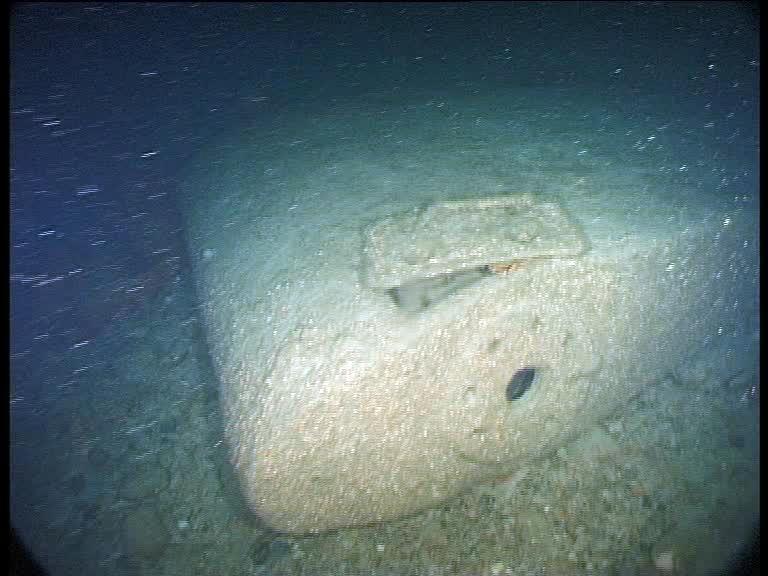
The huge single rudder lies on the seabed (Innes McCartney). 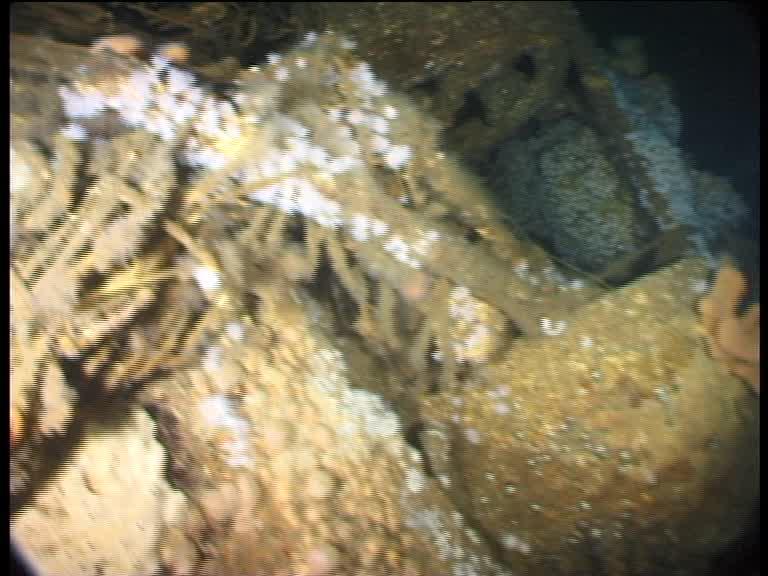
The forward flak turret and the aft one have their guns in situ. This is unique among the Operation Deadlight fleet. It was probably caused because U2506 was dumped very late (1946), having been held back until the end (Innes McCartney) 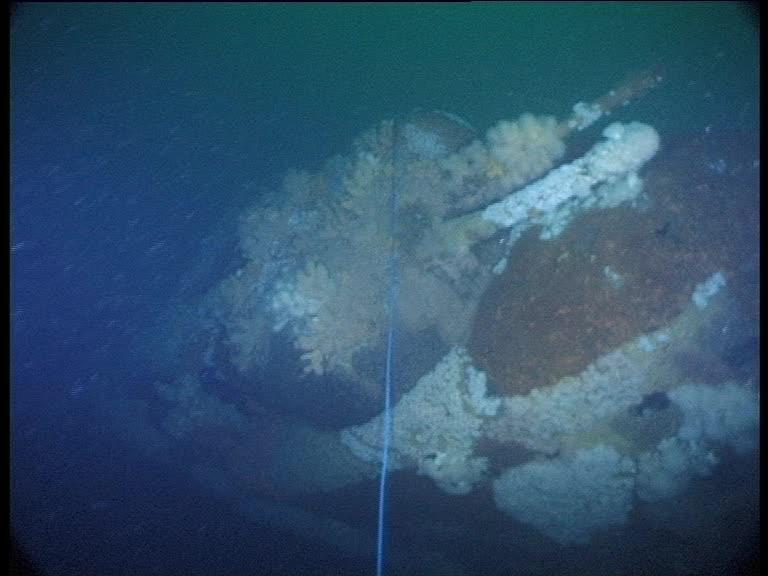
The aft flak turret is intact with both guns still in situ (Innes McCartney). 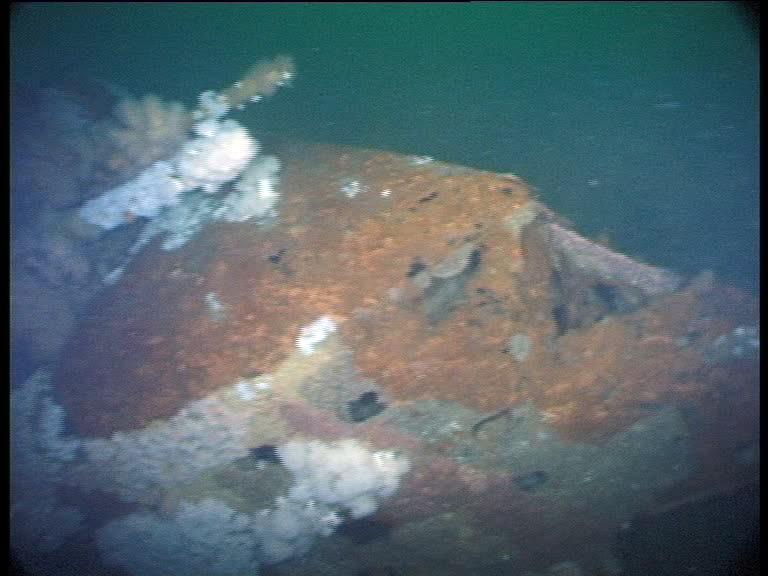
The hydrodynamic shape of this submarine (designed to operate permanently submerged) can be seen here with the tapered after end of the conning tower (Innes McCartney). 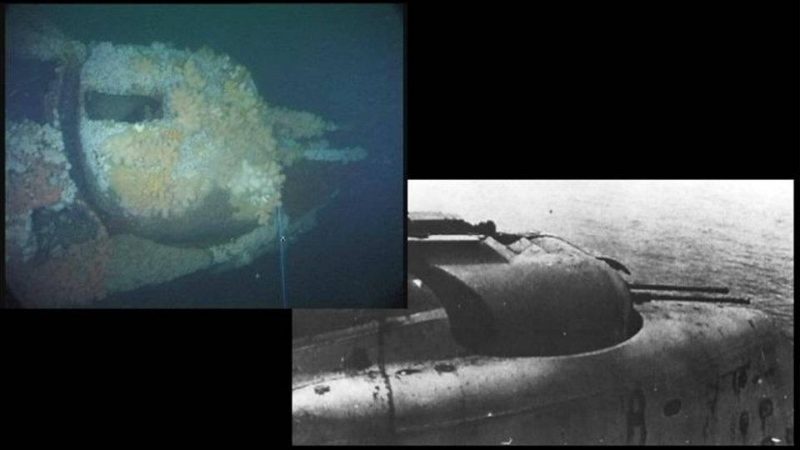
Aft flak guns still intact (Innes McCartney)
The radar absorbent “Wesch” coating is now covered in anemones (Innes McCartney). 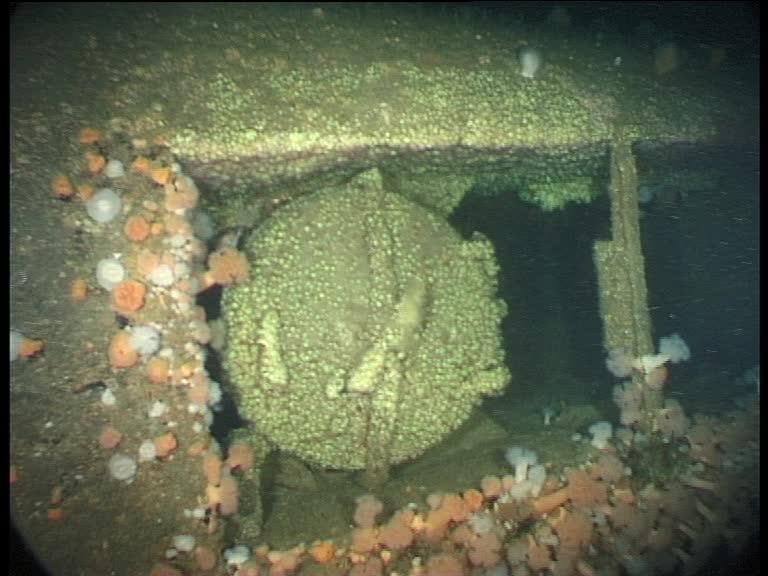
The forward life raft container (Innes McCartney). 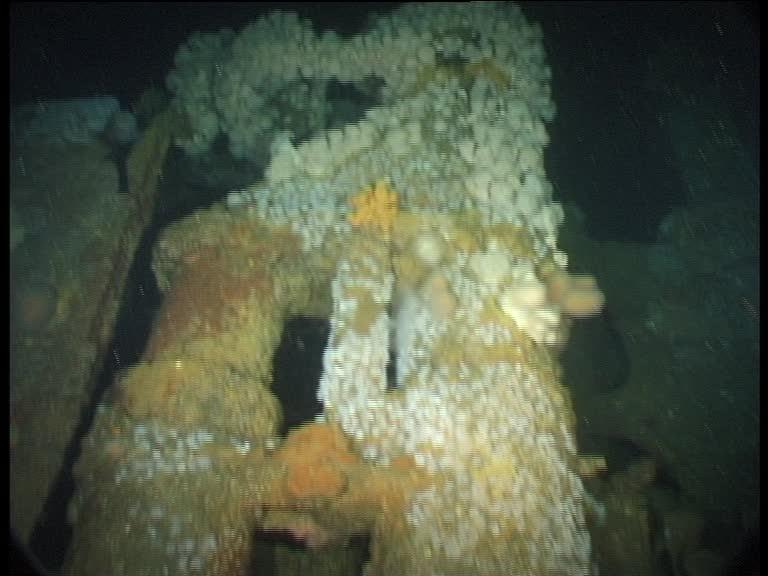
Unlike U2511 the snorkel is intact (Innes McCartney) 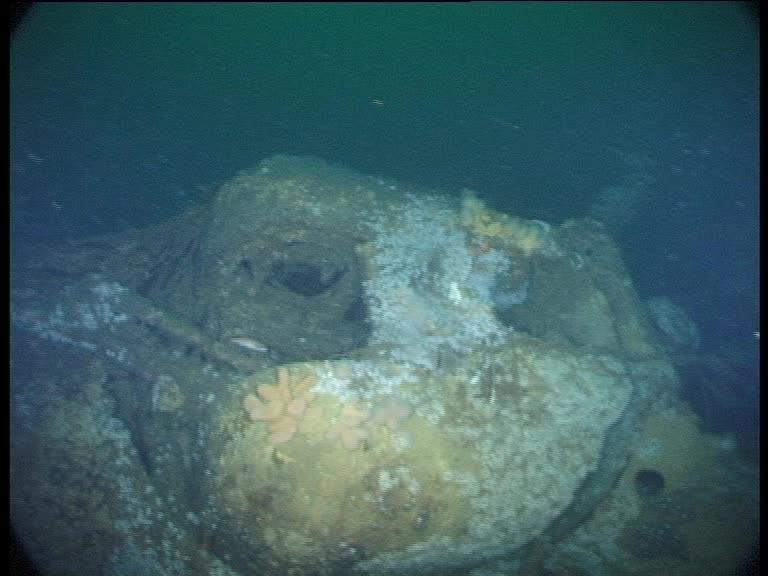
The forward Flak turret (Innes McCartney). 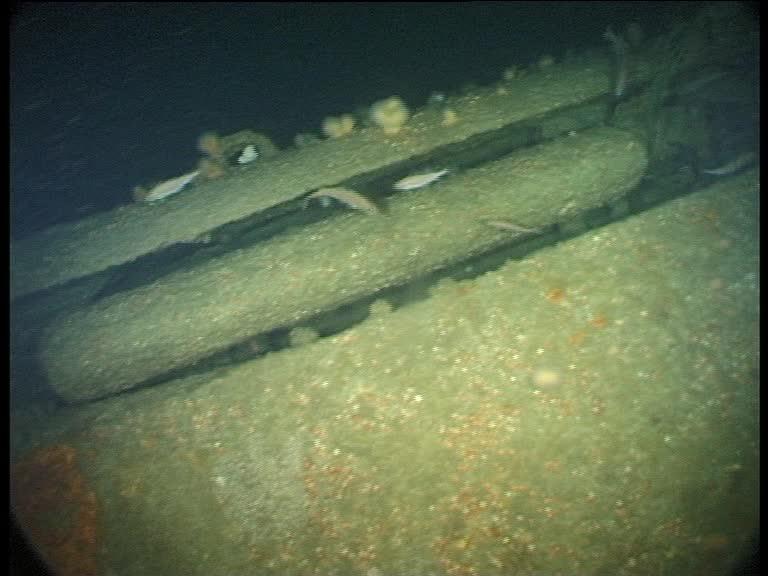
The hydroplanes folded inside the sub when coming alongside. The port side one in its recess (Innes McCartney) 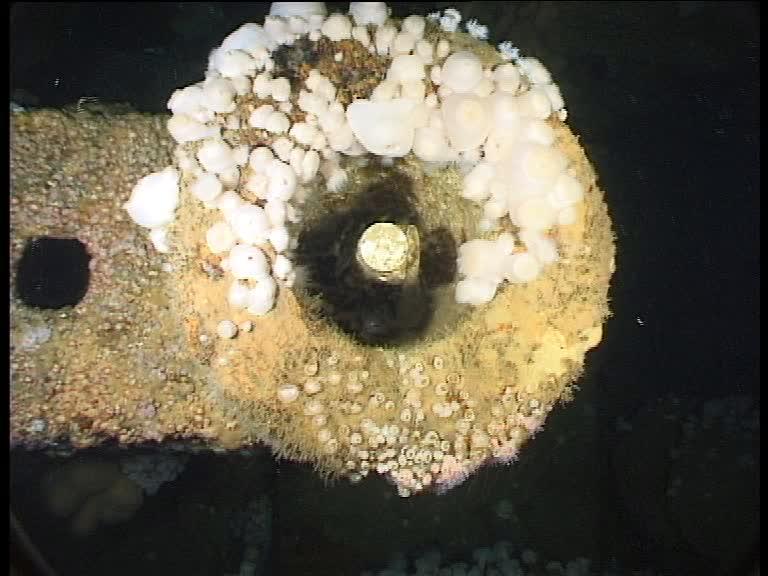
Attack periscope (Innes McCartney). 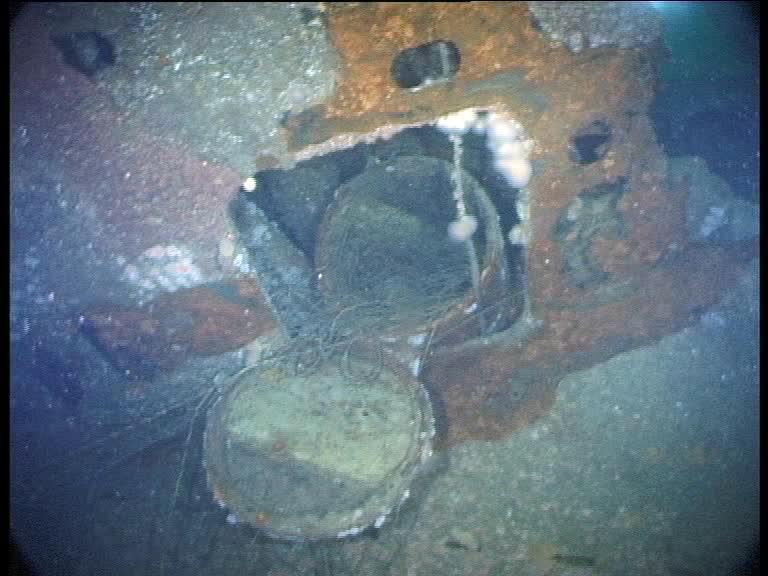
AT the base, an open life raft container (Innes McCartney) 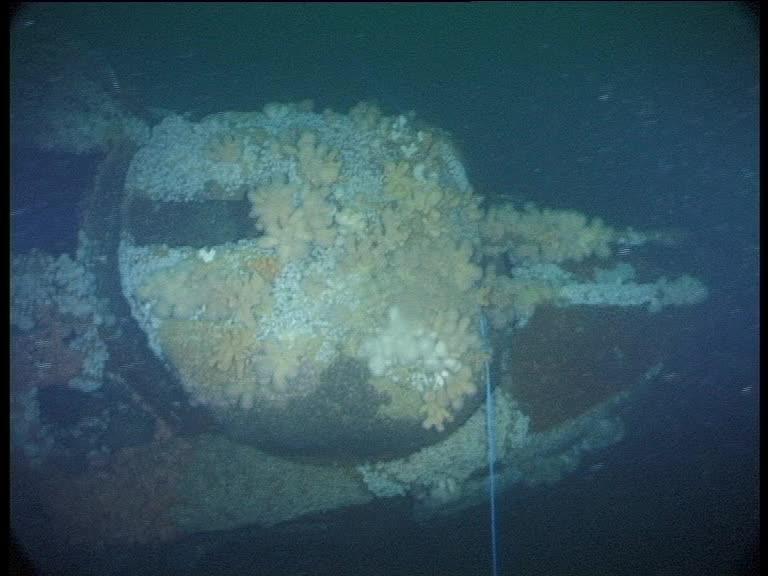
A sight to live long in memory. Not many have found a Type XXI electro boat (Innes McCartney). 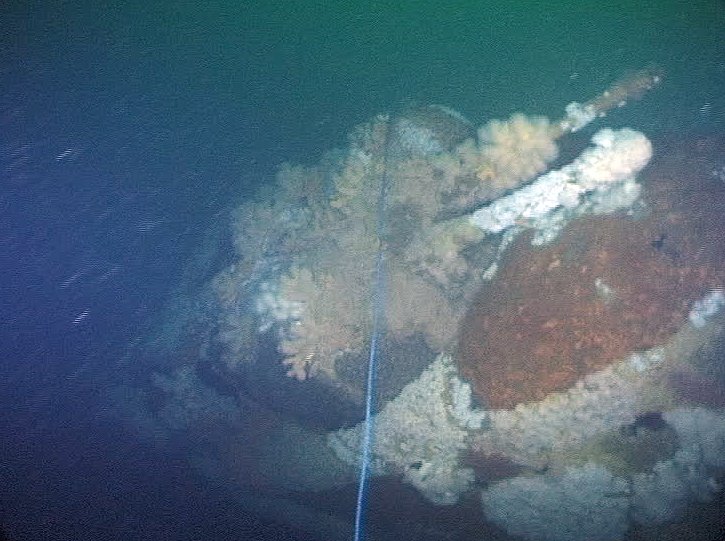
A sight to live long in memory. Not many have found a Type XXI electro boat (Innes McCartney).
Life raft container, U2511 has two at this location (Innes McCartney) 